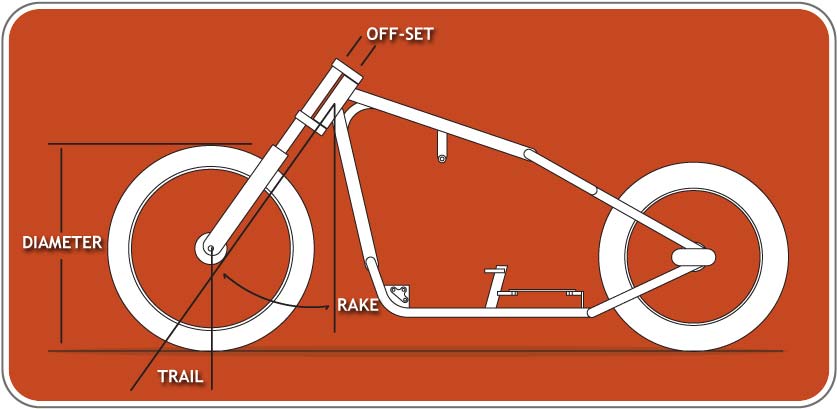Rake & Trail Calculator
WARNING: Still in development. Do not rely on measures for exact accuracy.
Rake and Trail Explained:
We know you were day dreaming about sex when the triangles were floating around the blackboard and you were doodling motorcycles while the teacher was explaining geometry and tangents. Now all these years later when you finally got the money to build your dream bike, all you can do is thumb through pictures of other people’s projects, searching for that “look” blissfully unaware of what all that trigonometry was for. We’re going to show you how to do the calculations. It might explain why shopping carts weren’t meant to go 200 mph.
Your front suspension geometry is defined by the following six variables which are:
OFFSET: Centerline of the top steering neck to the centerline of the top of the fork tubes.
RAKE: The angle in degrees of the steering neck from vertical.
FORK LENGTH: The distance between the top of the fork tubes to the centerline of the axle.
DIAMETER: The diameter of the front tire.
TRAIL: The distance defined by the vertical line from axle to ground and the intersection of centerline of the steering neck and ground.
RAKED TRIPLE TREES: In order to bring trail figures back into line, triple trees with raked steering stems can be used. Usually adjustable in 3, 5, 7 degrees of rake.
HOW TO MEASURE CORRECT TRAIL
Raise the bike to an upright position, using a tape measure, hold the tape straight down from the front axle to the floor. Put a mark on the floor at that point. Then place the tape parallel to the steering neck, following the angle of the steering neck all the way up to the floor. Put a mark here also. Now measure the distance between the two marks and you have your trail measurement. It should read between 2 and 4 inches. Note: If your bike is equipped with a rear suspension, have someone sit on the seat when you make the measurements to simulate your actual riding condition.
TOO LITTLE OR NEGATIVE TRAIL
With too little or negative trail (steering axle mark behind the front axle mark), the bike will handle with unbelievable ease at low speeds, but will be completely out of balance at high speed. It will easily develop a fatal high-speed wobble. EXTREMELY DANGEROUS!
NORMAL TRAIL
Normal trail is somewhere between 3 and 6 inches. The bike will handle easily at both high and low speeds. Flowing smoothly through curves without swaying or wobbling. If you use a very fat rear tire, you should keep the trail as close to 4 inches as possible.
TOO MUCH TRAIL
If the trail is more than 6 inches the bike will handle sluggishly at high speeds. It will seem almost too steady. You will have trouble balancing the bike at lower speeds or on winding roads. It will feel generally sluggish and clumsy.






